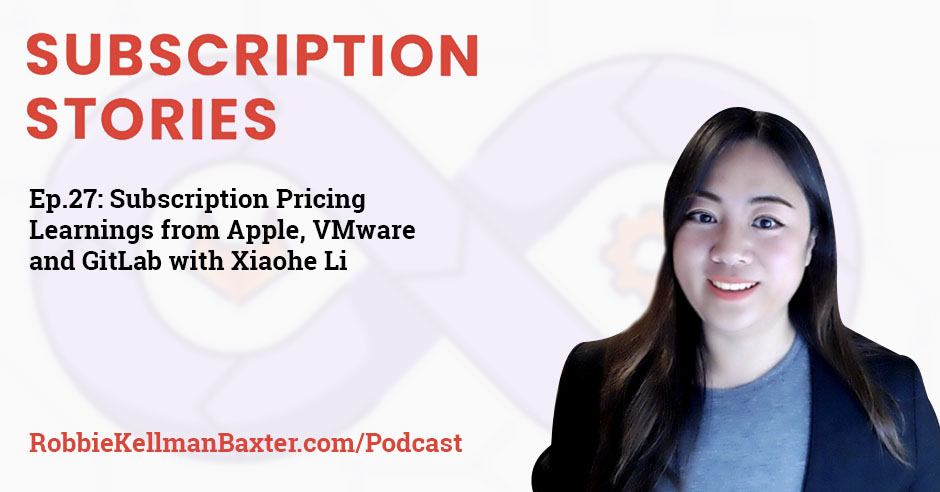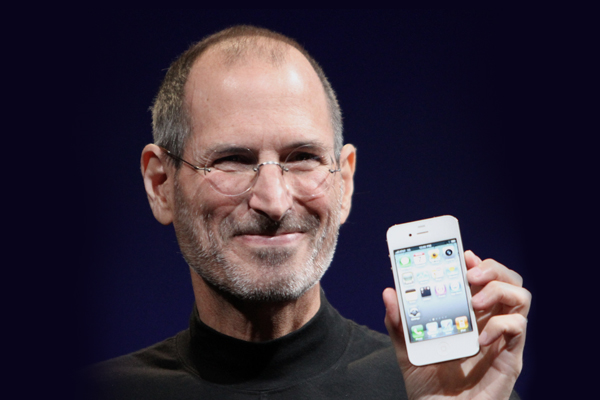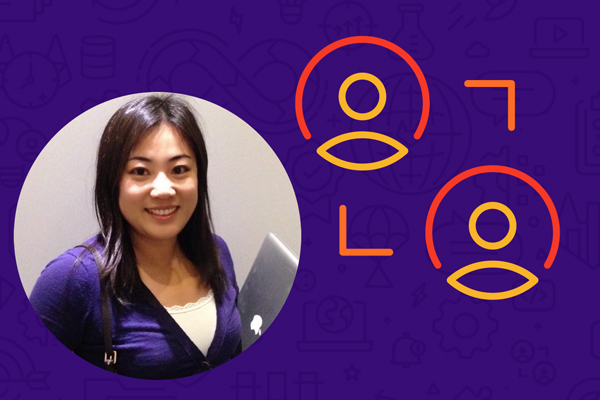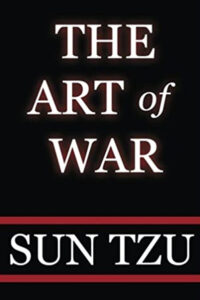
“Pricing is a holistic area. It’s science married with the arts and humanities.” Subscription pricing expert Xiaohe Li joins Robbie to talk about balancing the art and science of pricing strategy. She also opens up about the things she learned about pricing from her experience at three prominent membership organizations and what Sun Tzu has to teach us about pricing innovation.
Pricing is one of the trickiest parts of building a successful subscription model. You want to make the model simple, transparent and easy-to-understand, but you also want it to be optimized for each customer, and of course to maximize revenue and profitability. It can be tempting to offer multiple tiers for different use cases, as well as promotions and add-ons. Before you know it, you have a complex mess.
Today’s guest, Xiaohe Li, is an expert on subscription pricing, with experience at organizations including Apple, VMWare and now GitLab.
In our conversation, we cover what Xiaohe learned about pricing in the Membership Economy at three dramatically different organizations, how to balance the “art” and the “science” of good pricing strategy, and what Sun Tzu’s The Art of War has to teach us about pricing innovation.
—
Listen to the podcast here:
Subscription Learnings from Apple, VMware and GitLab with Xiaohe Li
Pricing is one of the trickiest parts of building a successful subscription model. You want to make the model simple, transparent and easy to understand, but you also want it to be optimized for each customer, and of course to maximize revenue and profitability. It can be tempting to offer multiple tiers for different use cases as well as promotions and add-ons. Before you know it, you have a complex mess. Our guest Xiaohe Li is an expert on subscription pricing with experience at organizations including Apple, VMware and now GitLab. In our conversation, we cover what Xiaohe had learned about pricing in the membership economy at three dramatically different organizations, how to balance the art and the science of good pricing strategy, and what Sun Tzu’s The Art of War has to teach us about pricing innovation.
—
Welcome to the show.
Thank you, Robbie. I’m delighted to be here and to have the opportunity to discuss subscription pricing.
I wanted to start by asking you if you could summarize your pricing philosophy as it is now?
My enterprise subscription/SaaS pricing paradigm is value-based consumption pricing. It is grounded in my decade long experience at both Apple and VMware.
Your pricing career began at Apple. Although you were focused on international pricing of hardware, and subscription was a small part of what Apple was doing at that time. You’ve told me that your time working at Apple provided you with some foundational ideas that impact how you think about subscription pricing now. Can you share a little bit about what you learned at Apple that is still useful in your work at GitLab?
Treat your customers as part of your team because eventually, they are going to be the consumer of you pricing strategy. Share on XApple embraces Business-to-Consumer and Business-to-Business hardware along with software and cloud service. My tenure at Apple shaped my thinking on subscription pricing from strategy to operations. I’d like to share three things that have deeply influenced me with regard to pricing strategy. The first thing is the belief in the power of simplicity. There are many different use cases. The tendency is to create an offer tailored to each new use case, which will soon lead to a complicated pricing model as a company grows. Rather– a simple, consistent pricing model is more effective so that customers won’t hesitate to make a purchase decision because they don’t understand which one is the best one for them and how much they’re going to be charged as a total cost of ownership.
Apple has frequently used a classic techniques to price products: Good. Better. Best. Good is the lowest price offer for a product line to get people in the door. Better is in the middle with more features, and Best is the most expensive at the highest end offer. When I focus on SaaS pricing and subscription pricing, later on, the Good, Better, Best pricing and packaging model is still the most powerful one. That’s the number one, the power of simplicity. The second thing is to focus on the long-term customer relationship and to drive profitable business for the company. The top question in pricing is not about how much I’m going to charge my customers. Instead, it’s about what value I deliver to them and what’s their return over investment. A lot of Apple customers use Apple products from generation-to-generation, including myself, because of the high return over investment. I use my iPhone and my MacBook throughout my day, every single day, far more than any other item purchased with a similar cost.
Pricing also plays a key role to support a sustainable and profitable business model. Only when the company is sustainable can the long-term relationship with the customer be viable. That’s the second thing I learned from my Apple experience. The third thing is to fully understand the competition, but not to simply follow or mirror them. Your competitors’ pricing should not be taken as your benchmark. You should be confident that you’ll have the capability to do a better job there to be the innovator and the leader in pricing. Those are the three key things I learned from my Apple time, which have been super powerful for subscription pricing and SaaS pricing later on.
You said that so beautifully. Simplicity, customer relationships, and make your own path are three important things that I hope people take away from our conversation. What’s fascinating to me is that the organizations where you’ve worked are good-sized companies. It’s very tempting to overcomplicate your pricing because you have lots of customers and to feel pressure to focus on short-term revenue goals or to try to respond to every competitor move.
I love what you said and how you clarified how a large organization can keep such focus. It’s also interesting to me that you’ve brought this forward into your work in a very different space. Now you’re working in SaaS, Software as a Service, that you’re selling. If Apple is primarily selling to consumers, now you’re working for a company that’s B2B, business-to-business and they sell Software as a Service. Do you believe those same principles apply?
Yes, I do.
You described the subscription-based pricing paradigm as value-based consumption pricing. Can you explain briefly what that means?
That’s not an easy thing to do though it sounds easy to say. First, there are two parts. The first part is “value-based”. There are different pricing strategies out there, cost plus, competitive, value-based, so on and so forth. Value-based means what your focus is neither about how much it costs you, nor about how much your competitors charged. It’s about what value you bring to your customer. That’s your foundation to start your pricing strategy. The second part is “consumption”. You want to make sure you provide very fair pricing for your customer based on their consumption, not based on other customers’ consumption.
Pricing is a holistic area. It’s science married with the arts and humanities. Share on XThe value-based piece is about focusing on how you improve your customer’s condition. In subscriptions, how do you help them achieve an ongoing goal or solve an ongoing problem? That’s the value. The consumption is whether or not they’re using it, and how much they’re using it. Right now, in the world of pricing, there’s a lot of debate on this. If you and I both subscribe to Netflix, and I watch 20 shows a week and you watch 1, should we pay the same price? I’m curious about what you think about the consumption piece in addition to the value-based piece.
Apparently, not all the offers are priced based on every single customer’s consumption. However, what I’m saying over here is forward-looking–We’ll get there one day. What we can do right now to drive the direction is: keep that in mind for all the pricing practitioners that we want to do the fair thing for every single customer.
People often give me that Netflix example about consumption, while some people don’t use Netflix. What Netflix does that is so fascinating is they invest pretty heavily in making sure you’re using the product. They make it easy for you to discover new content. They encourage you to go across categories, don’t just watch comedies, but maybe also try a documentary or a full-length feature film. It’s important for people reading to keep in mind both of these things. You want to create a lot of value and you also want to make sure that they’re getting the value that they’re paying for.
That’s why I’m saying that pricing is the area where science is married with both the arts and humanities.
You told me about an a-ha moment that you had one afternoon when you were walking between buildings in Infinite Loop at the Apple headquarters. Bring us back to that moment, where you were, what you were doing, and what you realized in that day?

Subscription Pricing: “In Apple’s DNA, that technology alone is not enough. It’s technology, married with liberal arts, married with humanities, that yields us the results that make our heart sing.” – Steve Jobs
If I’m not doing pricing, I’m probably becoming a philosopher or something. I like to think deeply even about pricing, which is my area. That day, while walking around the Apple Campus in the Infinite Loop, I saw a quote from Steve Jobs on the wall that said, “In Apple’s DNA, that technology alone is not enough. It’s technology, married with liberal arts, married with humanities, that yields us the results that make our heart sing.” I saw that and went, “A-ha, pricing is the area where science is married with both the arts and the humanities too.” Data-driven is a buzzword. You hear it a lot in terms of pricing strategy and decision-making. No doubt, it’s very critical to understand relevant data. That’s the foundation. However, data does not ultimately provide an obvious answer, especially concerning pricing strategy, which is highly complex. Experience, judgment and psychology bring the arts and humanities to complement the science of refining a pricing strategy.
That’s beautiful. As an English major myself, who studied Poetry, I appreciate that both you and Steve Jobs value liberal arts as well as the sciences in thinking about these important business questions, whether they’re about technology or pricing. I appreciate what you said and I hope people take this to heart that pricing is as much an art as a science, and that the goal is to connect in a meaningful way with the customer. This show is about subscriptions but I often say that subscriptions are just a pricing tactic that has to be justified by an underlying forever promise. A formal relationship between the customer and the company. You told me that Apple’s iPhone is a great example of a forever promise without subscription pricing, which I think is interesting. Can you share how they build a forever promise without charging you on a subscription basis?
I can’t agree with you more on this, Robbie. The underlying promise with various types of subscriptions is a long-term relationship with a customer. Here’s how I look at the iPhone pricing practice. Customers are not asked to subscribe to an iPhone when they buy one. The fact is, customers will most likely keep replacing their iPhone every 2 to 3 years, just like the renewal in a multi-year subscription model. The secret of the iPhone model is not to focus on the price point but rather to guarantee the value of greater functionality, which customers get out of the iPhone. This is a forever promise rooted in the customer relationship with Apple. Apple customers are long-term customers even without a visible subscription.
When I first started doing my work on membership, people would say, “Apple? I’m a member there.” “I’m a member of Apple.” “I buy whatever they tell me to buy because it all works together and because I depend on it so much.” I’ve continued to take that as a good example of why, even though of course, I love subscriptions, why the subscription pricing has to follow the value creation and the relationship that’s established. Once you have an ongoing relationship with your customer, you can charge on a subscription basis.
If you have an ongoing relationship with your customer, you may not even need to charge on a subscription basis. You can continue as Apple did to charge for the outright purchase of the hardware product. That’s a good example. I want to go in a different direction. After Apple, you went to VMware, a very different business. Leading cloud computing virtualization software, very tech, very businessy. When you got there, what was that experience like? What was the mandate that you were given? What did you notice having grown up as a pricing professional at a very consumer-focused business and then popping in at a B2B software company?
VMware endorses enterprise software and the cloud. Before I address the pricing model and pricing-related equations, I’d like to emphasize that VMware has a very sophisticated business model for many reasons. To highlight a few, VMware has multiple go-to-market routes: sell to the customer directly, two-tier channel, which means distributors and partners. Partners purchase from distributors.

Subscription Pricing: A simple, consistent pricing model is more effective so that customers won’t hesitate to make a purchase decision.
That’s a lot of different ways of selling. You can already start to see all of the different pricing variations that VMware has to manage and has to think about. They have a lot of customers because the partners are customers, they have the buyers at the companies, and then they have the end-users. It’s super complicated. When you came in, you said it was already a pretty sophisticated and complex pricing structure.
On top of that, VMware also offers very flexible deployment methods and pricing. For example, on-premises subscription, on-premises perpetual, SaaS, and other innovative models. Think about all of those with multiple product lines. It is extremely important to ensure that pricing is consistent among product lines, pricing models, and the go-to-market. When I was there, one of my focuses was to simplify the pricing strategy and also drive consistent pricing models across different product lines.
It’s very common that as an organization is successful and expands, pricing gets increasingly complex. This is a very good example of what happens to a lot of organizations as a result of their own success. They get this very complicated pricing structure. How did your philosophy change after your time at VMware? Did it expand? Did you put a little asterisk next to simplicity, like keep it as simple as possible but if you have a lot of different B2B customers, buyers and users, then you get a little more leeway? Did you change your philosophy at all as a result of your time at VMware?
As a matter of fact, it strengthened my philosophy of the power of simplicity because I witnessed how important it is to pay a lot of attention, not to complicate pricing from the beginning nor overtime. The other thing that I learned from my VMware time is in the business-to-business software in a cloud world, it is super critical to collaborate. Make a lot of efforts to collaborate with your customers side-by-side. It was much easier to do so, to put ourselves into customers’ shoes in Business-to-Consumer products like iPhone as we, ourselves, are the customers too.
Lead with vision instead of simply following others. Share on XHow do you do that? How do you bring your customers into the pricing process?
You have to feel your customers are part of your team. Set up a regular cadence to meet with them, talk to them, and listen to them. It’s not after you make the decision. It’s before you make the decision. When you initiate a new idea and you want to have the selected customers by segments to be part of the journey from the beginning. You treat them like your regular team or as your best advisor because eventually, they are going to be the consumer of your pricing strategy.
That’s very bold and very powerful that you’re bringing in your customers as part of your team as important advisors on the pricing strategy. A lot of times, people bring in the customer in the product development or to see if the marketing message is resonating, but to talk to them and understand their usage as part of your pricing strategy is pretty unusual. Do you see this with your pricing peers at other organizations? Are they equally customer-centric? Do you think this is a trend?
I think this is a trend and this is the future. Collaboration with the customers should be the key for any pricing organization. That’s one of the secrets to being successful.
You’re at GitLab, which is the third type of business, also Software as a Service, but a true subscription native company. No historical on-prem solutions, no old hardware model, or subscription native. Can you talk to me about the pricing model at GitLab and the overarching philosophy in your work there?
GitLab advocates a three-tier model, Good, Better. Best. One free tier and the two paid tiers, which we call Premium and Ultimate. Free is for a single developer as GitLab is a DevOps application and the Premium is for team usage. Ultimate is for strategic organizational usage. The customer also has the flexibility to choose between a self-managed instance and GitLab- hosted SaaS.
What I liked about the way you describe the pricing, good, better, best. One, free. Two, paid, and very clear target audiences and use cases for each of those offerings. I have a lot of clients that are starting out with pricing and they’ll often want to go to a good, better, best model right away without knowing who they’re serving and why would somebody need each one. This is a good example of knowing why you have each tier, having a clear value proposition, a clear audience, and use case for each one of them. I know that you removed one of your tiers. Can you talk me through that story and explain? It’s very hard for a lot of companies to remove a pricing option. Usually, it’s all about adding more and more options. Can you talk me through how you came to make that decision to remove a pricing tier?
Before that, I want to talk about the free tier a little bit more. Giving a great free product is part of the go-to-market at GitLab because GitLab wants to be a good steward of the open-source product. That’s very important. As you said, removing a pricing tier is neither a small nor an easy decision. The decision process included four key critical steps. The first step was to decide on a pricing strategy which was to end the availability of the lowest-paid tier to drive customer/product fit. The lowest pricing tier fulfilled our original goal. Now, it causes customer/ product mismatch. Also, the tier does not meet the hurdle rate that the company expects from a tier and it is limiting GitLab from investing to improve the products for all of the customers.
You had these tiers and one of the tiers was not working as well. It didn’t seem to fit with the needs of the customers and it wasn’t as profitable.
That’s correct. The second step in the decision-making process was very critical too. It was to align on our transition principle. It was our central principle to transition customers when we remove a tier.
The first thing you did is you said, “This tier isn’t working.” The second thing that you did is you said, “If we’re going to remove it, we have to have a clear migration plan. A clear transition plan for all the people that have already subscribed at that level.”

Subscription Pricing: Collaboration with the customers should be the key for any pricing organization.
That’s exactly right. Even before that transition plan, what I want to stress here is a transition principle because there could be many different ways when you transition customers. What’s the most important thing we believe we want to do for this transition? That’s the transition principle. We understood that some customers won’t be ready to upgrade immediately. Before we even decided on the details of the transition plan, we aligned on a central transition principle, which is to make sure to offer a customer-friendly pricing policy that ensures a smooth experience for our customers.
I get it. That’s so important. The principle first and then you say how you do it. There are many choices but the important thing is it has to be customer-friendly.
All the plans and details should be around this principle. That’s what we’ve been sticking with.
First, you decided this tier doesn’t make sense anymore. The second thing is you said, “What are the principles about how we’re going to transition people off of it?” Customer-first and customer-friendly, and then what came next?
Next was to determine the legacy pricing policy, the plan itself, and how to help customer transition. GitLab gave it a great deal of thought. We conducted thorough research to validate the hypothesis before finalizing all the details of our three-year transition journey.
I hope you hear that. It doesn’t always happen quickly because there are real people that are dependent on your real subscriptions. Moving them forward in a customer-friendly way might take a long time. That’s a great nugget. What was the fourth piece of this?
The fourth one is to determine the communication and collaboration plan with customers and how to notify customers.
It’s so interesting to me that you take a very broad view of pricing. You’re thinking about customer-friendly, customer-journey and value creation. Most people, when they think about pricing, some analyst looking at the efficient pricing frontiers, pricing elasticity, and just looking at the numbers. You’re talking about the product, marketing, support, and customer success. It’s part of a holistic exploration of pricing. It’s a different way of looking at pricing.
Pricing is a holistic area. It’s science married with the arts and humanities.
Looking back over the years, you’ve done a lot of different things with pricing and that was honestly one of the reasons I wanted to bring you to the show. It’s to share some of these principles that hold steady across very different kinds of businesses and also to understand what’s different with each of them. Looking back, how would you summarize your pricing philosophy? How would you describe it to somebody getting into pricing if they were asking you for advice? What would you advise them when thinking about pricing?
The three principles that have been extremely effective for me are: Number one, advocate the power of simplicity. Number two, focus on a long-term relationship with the customer. Number three, create mutual benefits, great return over investment for the customer, and excellent profits for the company.
Do you think competitive pricing should be considered as you’re developing your pricing, or should you innovate your own pricing structure without even worrying about what others are doing?
I’m a big fan of history and have been inspired by ancient wisdom from both the Eastern world and the Western world. One of my favorite books is by Sun Tzu, who is a Chinese military strategist, philosopher, and writer from about 2,000 years ago. The book is called The Art of War. There is a chapter in it saying “知彼知己,百战不殆;不知彼而知己,一胜一负;不知彼,不知己,每战必殆”. Translated into English, it means “If you know your enemies and know yourself, you will win 1,000 battles without a single loss. If you only know yourself but not your opponent, you may win or you may lose. If you know neither yourself nor your enemy, you will always endanger yourself.” This can be perfectly applied to pricing. You need to understand your competitors’ offers and your own offer extremely well to have a pricing strategy to achieve your goal and win the market. On top of that, I highly encourage pricing innovation. Lead with vision instead of simply following others.
I want to do the speed round with you. Answer the first thing that comes to your head. The first subscription you ever had?
Good Kids Magazine when I was five years old. My dad subscribed to Good Kids Magazine. It had a big impact on me. It had stories. I still remember one of the stories, which was about a little pig whose name is Hu Lulu. He’s kind, humorous and funny. I took him as one of my childhood friends.
Favorite subscription?
Favorite free offering?
A time that you felt like a member like you belong to something?
It was back to my Apple time. The example I gave to you on iPhone because that’s truly my feeling about how I use the iPhone and Apple products. I didn’t subscribe to anything back then but I felt I was a member.
That’s a great example and such a powerful one. They don’t even need the subscription handcuffs to keep people. People want the products and want the products to work together. Thank you so much, Xiaohe, for being my guest in this episode. We’ve got so many bits of wisdom around pricing as well as a higher-level pricing philosophy that any subscription practitioner can keep in mind as they’re building their model. Thank you so much for coming on the show and sharing all of your expertise.
It’s been a pleasure to be here. Thanks for having an episode on subscription pricing and packaging.
—
That was GitLab’s Xiaohe Li. For more about Xiaohe and GitLab, go to GitLab.com. For more about Subscription Stories, go to RobbieKellmanBaxter.com/podcast. Also if you liked what you heard, please go over to Apple Podcasts or Apple iTunes and leave a review. Mention this episode if you especially enjoyed it. We read all the reviews because we want your feedback. Thanks for your support, and thanks for tuning in to Subscription Stories.
Important Links:
- Xiaohe Li, Pricing and Packaging Strategy/VMware, Apple, Deloitte Consulting, CMU alumni
- Apple
- VMware
- GitLab
- Buy The Art of War on Amazon
- Netflix
- MyFitnessPal
- Apple Podcasts – Subscription Stories
About Xiaohe Li
 Xiaohe Li became part of GitLab with a mission to build a brand new pricing and packaging function. As the world’s largest all-remote organization, GitLab is an open core company, developing software for the software development lifecycle deployed by more than 100,000 organizations and 30 million estimated registered users. GitLab believes in a world where everyone can contribute.
Xiaohe Li became part of GitLab with a mission to build a brand new pricing and packaging function. As the world’s largest all-remote organization, GitLab is an open core company, developing software for the software development lifecycle deployed by more than 100,000 organizations and 30 million estimated registered users. GitLab believes in a world where everyone can contribute.
Before joining Gitlab, Xiaohe played an integral role in VMware’s B2B pricing strategy across on-premises software, subscription and SaaS offers. Moreover, she devised the APJ pricing council and orchestrated the global customer purchase program.
Apple was where Xiaohe realized her affinity for pricing, specializing in international pricing aimed at over a billion users worldwide. Prior to Apple, her formative professional years were spent at Deloitte Consulting.
Xiaohe is passionate about cutting-edge technology, and SaaS pricing and packaging strategy, while philosophy, education, and hiking nourish her creativity. She lives with her family in Silicon Valley. One of her childhood heroes is the Monkey King, from whom she learned a growth mindset and to believe anything is possible.
Love the show? Subscribe, rate, review, and share!



